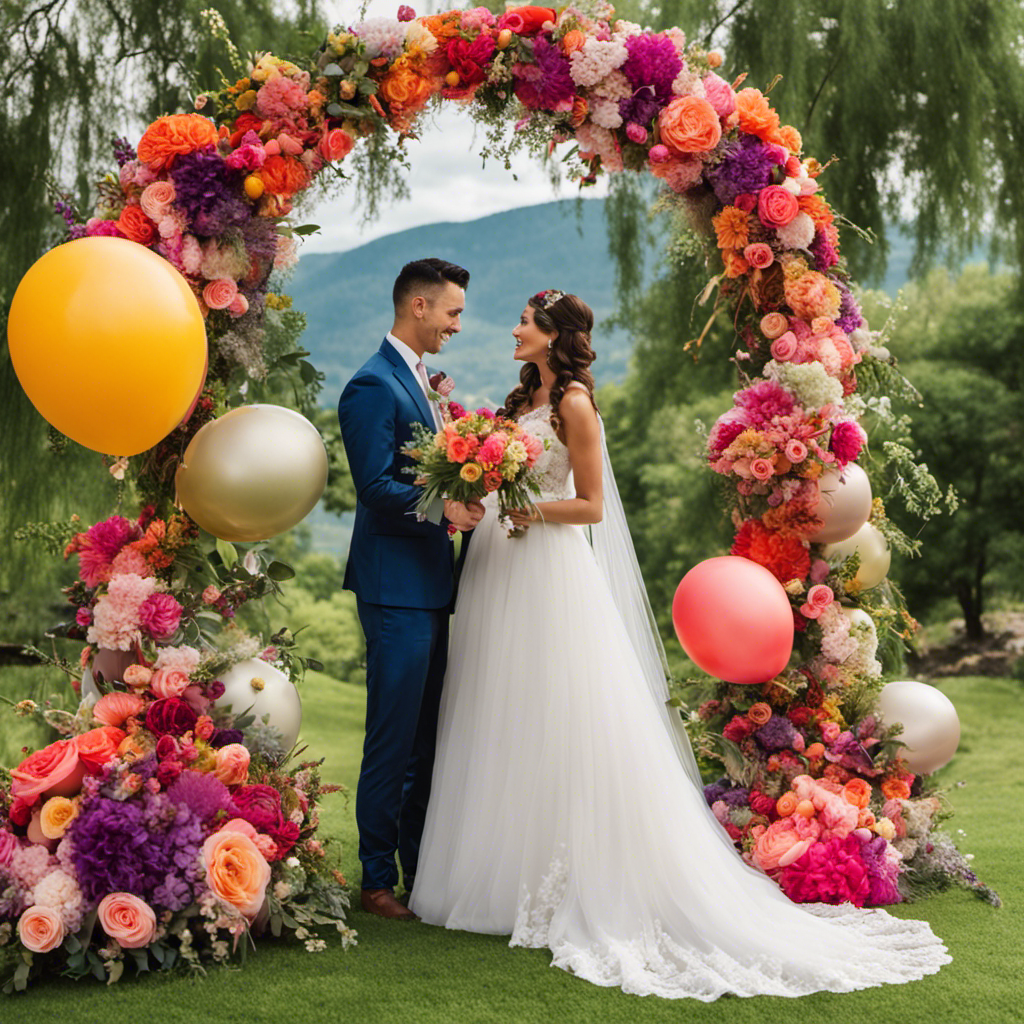Architecture Home Styles
10 Disadvantages of Shingle Roofing You Should Know
Get ready to unravel the hidden downside of shingle roofing – a crucial revelation that may reshape your perspective on this popular choice.
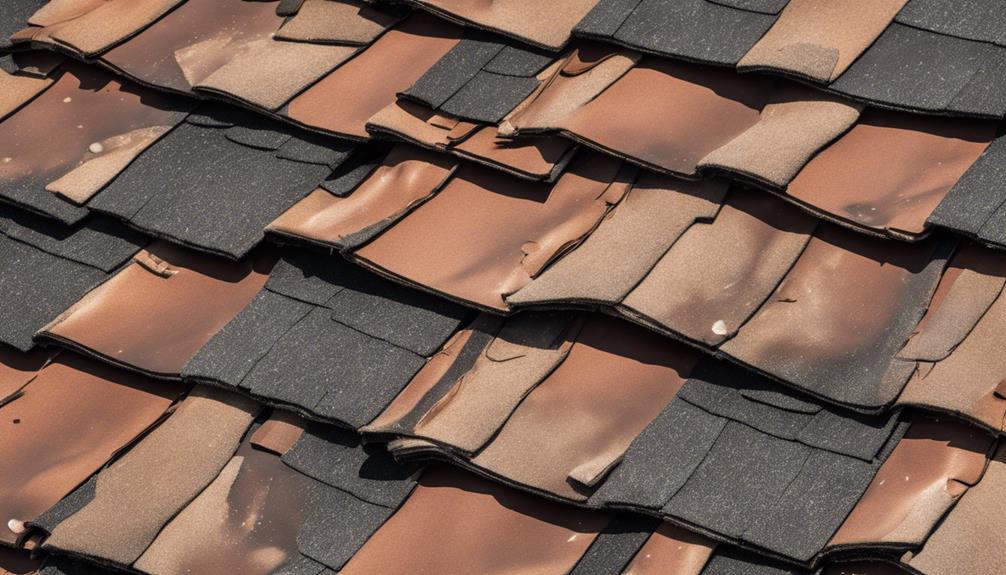
When exploring the realm of shingle roofing, it's imperative to consider the multitude of drawbacks that come with this popular choice.
As we uncover the intricacies of shingle roofing, we'll come to understand how factors like limited longevity, susceptibility to weather damage, and high maintenance requirements can significantly impact your roofing decision.
However, there's one key disadvantage that often goes unnoticed, lurking beneath the surface and waiting to be revealed.
Key Takeaways
- Limited lifespan of 15-30 years.
- Vulnerability to weather damage and high maintenance costs.
- Environmental challenges in production and disposal.
- Limited warranty coverage with potential restrictions.
Lack of Longevity
When considering the disadvantages of shingle roofing, one must be aware of the limited longevity that asphalt shingle roofs offer compared to other roofing materials. Asphalt shingles, while popular for their affordability and ease of installation, come with a drawback – a shorter lifespan ranging from 15 to 30 years.
This reduced longevity is exacerbated by factors such as excess moisture and heat, which can accelerate the deterioration of asphalt shingles over time. The presence of excess moisture, whether from heavy rainfall or high humidity levels, can lead to the rapid breakdown of the shingles, compromising their ability to effectively protect the underlying roof structure.
As asphalt shingles deteriorate, they become more susceptible to damage, exposing the roof to potential leaks and further structural issues. Therefore, the limited lifespan of asphalt shingle roofs underscores the importance of regular maintenance and proactive measures to mitigate the impact of environmental factors on their durability.
Susceptibility to Weather Damage
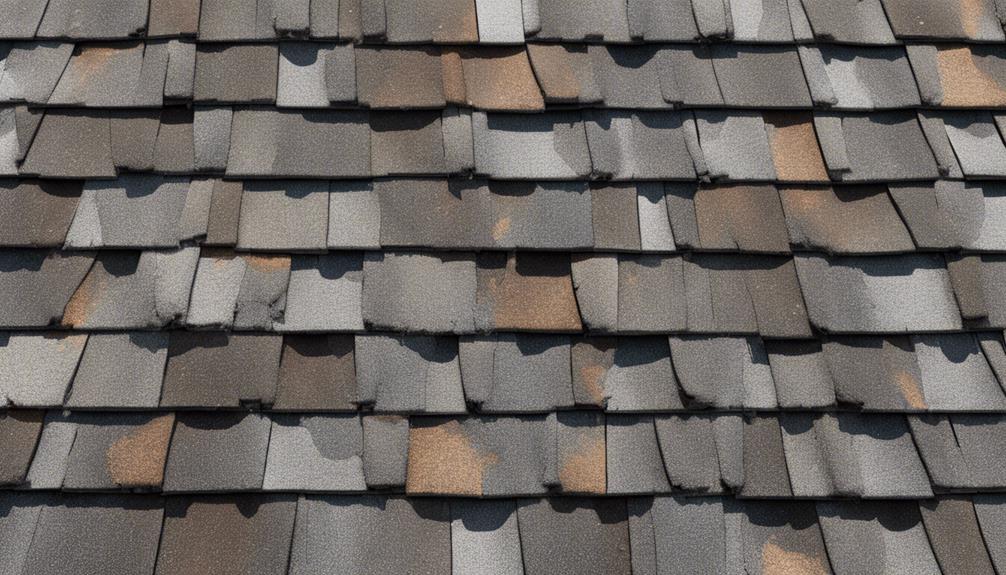
Shingle roofs are highly susceptible to weather damage, with strong winds posing a significant threat to their integrity.
Debris and tree branches can easily cause harm to shingles, leading to potential roof issues.
Due to their vulnerability to weather conditions, shingle roofs often require increased maintenance and repair costs to address the damage incurred.
Weather Damage Risks
Being highly susceptible to weather damage, shingle roofs face significant risks of deterioration and structural compromise. When it comes to weather damage risks, shingle roofs are particularly vulnerable to strong winds, which can lead to uplift and tearing.
Additionally, debris and tree branches pose a threat to shingles, increasing the likelihood of weather-related issues. The comparative susceptibility of shingle roofs to wind damage, as opposed to other roofing types, can significantly impact their durability.
These risks emphasize the importance of regular maintenance and inspections to mitigate potential damage and ensure the longevity of shingle roofs. Regular upkeep can help address issues promptly, preserving the integrity of the roof against weather-related challenges.
Impact on Longevity
With a lifespan typically ranging from 15 to 30 years, the impact of weather damage on the longevity of shingle roofing is a critical consideration for homeowners. Shingle roofs are more vulnerable to weather damage, especially from high winds which can lead to uplift, tearing, and reduced durability. The exposure to elements like debris and tree branches further accelerates the wear and tear on shingle roofs, shortening their lifespan compared to more resilient roofing materials. Below is a table highlighting the susceptibility of shingle roofs to weather damage, particularly high winds:
| Aspect | Impact on Shingle Roofs |
|---|---|
| High Winds | Increased risk of uplift, tearing, and damage |
| Debris | Accelerates wear and tear |
| Tree Branches | Can cause physical damage and reduce longevity |
Maintenance Costs Increase
Regular maintenance of shingle roofs due to their vulnerability to weather damage can result in increasing costs over time as repairs and replacements become necessary. Weather damage, such as shingle uplift and tearing, can lead to higher repair costs, necessitating more frequent inspections and repairs.
Neglecting maintenance on a shingle roof can result in more extensive damage and even higher repair expenses in the long run. Here are some key points to consider regarding the maintenance costs increase associated with shingle roofing:
- Shingle roofs require regular maintenance due to susceptibility to weather damage like wind, rain, and snow.
- The costs of maintenance for shingle roofs can increase over time as repairs and replacements become necessary.
- Weather-related damage can lead to higher maintenance expenses.
High Maintenance Requirements

Maintaining a shingle roof demands consistent attention to prevent various issues that could compromise its integrity and longevity. Regular inspections are essential to catch problems early on, such as moss and algae growth, which can lead to deterioration if left unchecked. Cleaning debris and leaves from shingles is crucial to prevent clogging and potential roof leaks. Additionally, periodic repairs may be necessary to fix damaged or missing shingles, especially after severe weather events. To emphasize the importance of these maintenance requirements, consider the following table:
| Maintenance Tasks | Importance |
|---|---|
| Regular Inspections | Identify issues early before they escalate |
| Cleaning Debris and Leaves | Prevent clogging and potential roof leaks |
| Addressing Moss and Algae Growth | Maintain roof integrity and prevent deterioration |
Limited Eco-Friendliness

Asphalt shingles aren't the most eco-friendly option available, with their production and disposal processes posing environmental challenges. While there are eco-friendly alternatives on the market, asphalt shingles still remain a common choice due to their affordability and availability.
The impact of using asphalt shingles on the environment is significant, especially when considering their lack of recyclability and high energy consumption during manufacturing.
Eco-Friendly Alternatives Exist
When exploring roofing options, it becomes evident that eco-friendly alternatives do exist, albeit with limitations in their eco-friendliness. Some sustainable roofing options that offer a more environmentally friendly choice include:
- Metal Roofs: Metal roofs are long-lasting and recyclable, reducing the need for frequent replacements and minimizing waste.
- Slate Roofs: Slate is a natural material that can last for decades, providing durability and reducing the environmental impact of roof replacements.
- Green Roofs: These roofs are covered in vegetation, offering insulation benefits, reducing energy consumption, and contributing positively to the environment.
While these alternatives have their eco-friendly advantages, it's essential to consider their specific limitations to make an informed decision for your roofing needs.
Not the Greenest Option
Despite advancements in roofing technology, the eco-friendliness of asphalt shingles remains limited due to various environmental concerns.
Asphalt shingles, commonly used in roofing materials, aren't environmentally friendly. They contribute to landfill waste as they're non-biodegradable. The production process of asphalt shingles emits toxic fumes and consumes high amounts of energy, negatively impacting the environment. These shingles contain petroleum-based products, further exacerbating their environmental footprint.
Unlike some other roofing materials that are easily recyclable, asphalt shingles pose a challenge in terms of recycling, adding to their ecological consequences. Opting for asphalt shingles may not align with sustainable building practices due to their limited eco-friendliness.
Considering the environmental impact of roofing materials is crucial in making eco-conscious decisions for construction projects.
Impact on Environment
With its limited eco-friendliness, asphalt shingle roofing raises significant environmental concerns due to its non-recyclable nature and high energy consumption during production. Asphalt shingles pose the following environmental impacts:
- Non-Recyclable: Asphalt shingles are challenging to recycle, leading to increased landfill waste.
- Petroleum-Based: These shingles contain petroleum-based products, further diminishing their eco-friendliness.
- High Energy Consumption: The manufacturing process of asphalt shingles requires substantial energy, contributing to environmental strain.
Considering these factors, the environmental impact of asphalt shingle roofing is considerable, highlighting the need for more sustainable roofing alternatives to mitigate these drawbacks.
Potential for Algae and Moss Growth

Algae and moss growth on shingle roofs poses a common issue due to their tendency to thrive in moist and shaded areas, particularly on the north-facing sides of roofs. These unwelcome green invaders can lead to discoloration and unsightly appearances on asphalt shingles. Moreover, algae and moss have the pesky habit of retaining moisture, which can accelerate the deterioration of the shingles over time.
To combat this problem, proactive roof maintenance is key. Regular inspections and cleaning can help prevent and control algae and moss growth. Specialized cleaning solutions designed to remove these organisms are available, as well as preventative measures like installing zinc or copper strips along the ridge of the roof. These metals release ions that inhibit the growth of algae and moss, helping to maintain the integrity and appearance of the shingle roof for a longer period.
Noise During Extreme Weather

During severe weather conditions, such as heavy rain or hail, the impact of these elements on shingle roofs can result in noticeable noise levels inside the house. This noise can be disruptive and may affect the comfort of the residents.
Here are some key points to consider regarding the noise generated by shingle roofs during extreme weather:
- The sound of rain hitting shingles can be amplified indoors, potentially causing disturbance or discomfort.
- The noise from hail impacting shingles during a hailstorm can be particularly loud and alarming, disrupting the peace and quiet of the indoor environment.
- The intensity and duration of the extreme weather conditions play a role in determining the level of noise experienced inside the house.
For homeowners residing in areas prone to frequent severe weather, the noise produced by shingle roofs during storms can be a notable drawback, impacting the overall living experience during inclement weather.
Limited Warranty Coverage
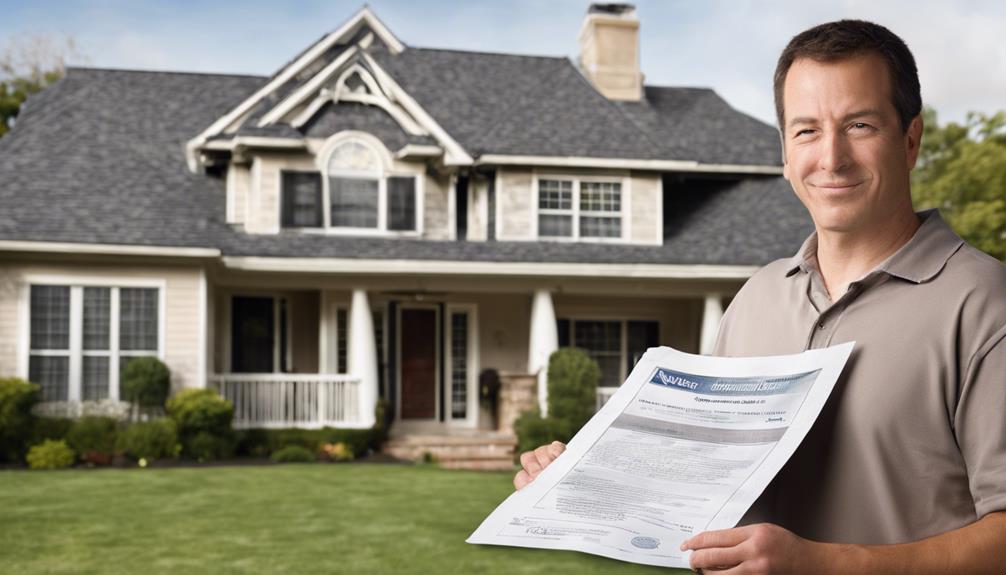
When it comes to limited warranty coverage for shingle roofing, it's crucial to be aware of the potential restrictions and exclusions that may apply. These limitations can include factors like labor costs, which mightn't be covered under the warranty, leading to out-of-pocket expenses for homeowners.
Additionally, some warranties may diminish in coverage over time, leaving homeowners with decreasing protection as their roof ages.
Warranty Restrictions
Understanding the limitations and conditions of a shingle roof warranty is essential for safeguarding our investment in the long-term durability of our roof. When delving into warranty restrictions, we encounter a variety of factors that could impact the coverage and longevity of our roof:
- Limited warranty coverage for asphalt shingle roofs typically spans 15 to 30 years, varying between manufacturers.
- Warranty restrictions might exclude specific damages like wind or algae growth from being covered under the warranty.
- Some warranties may necessitate regular maintenance and inspections to uphold their validity.
Being aware of these warranty conditions can help us make informed decisions when selecting a shingle roof, ensuring that we understand and comply with the warranty terms for maximum protection.
Coverage Exclusions
To ensure proper protection for our shingle roof investment, it is crucial to be aware of the coverage exclusions within the limited warranty, which may include specific conditions such as damage from acts of nature and improper installation or maintenance. Warranty exclusions for shingle roofing often involve scenarios like damage from extreme weather events, inadequate ventilation or insulation, and issues arising from improper care. Here is a breakdown of common coverage exclusions in shingle roofing warranties:
| Coverage Exclusions | Description | Examples |
|---|---|---|
| Acts of Nature | Damage from hurricanes, tornadoes, and storms | Roof shingle loss due to strong winds |
| Improper Installation | Damages resulting from incorrect installation | Leaks caused by poorly installed shingles |
| Lack of Maintenance | Issues due to the lack of proper roof upkeep | Rotting shingles from neglect |
Installation Complexity
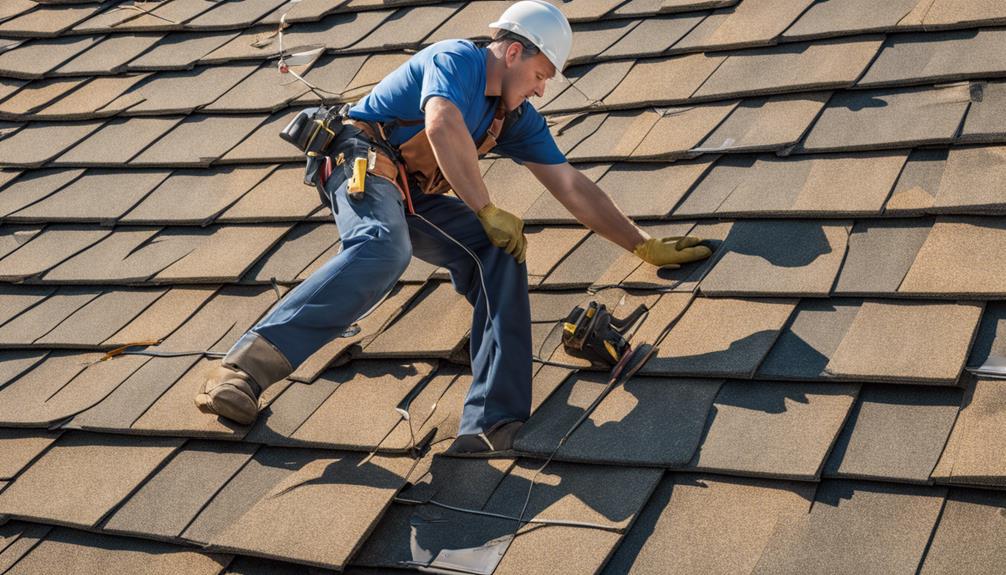
Navigating the complexities of shingle roof installation demands precision and expertise to ensure a durable and watertight roofing system. When it comes to shingle roof installation, proper sealing techniques are crucial to prevent leaks and water damage.
The following points highlight the intricacies involved in shingle roof installation:
- Alignment Precision: Each shingle must be aligned correctly to create a seamless and protective barrier against the elements.
- Underlayment Inspection: Checking the underlayment for any damage or gaps is essential to maintain the roof's integrity.
- Flashing Installation: Proper installation of flashings around roof penetrations like chimneys and vents is vital to prevent water infiltration.
Failure to address these complexities can lead to voided warranties and compromise the longevity of the roof. It's crucial to entrust this task to certified professionals to ensure a well-installed shingle roof that stands the test of time.
Discoloration Over Time

When it comes to shingle roofs, one common issue that property owners may face is the gradual discoloration of asphalt shingles over time. Asphalt shingles can fade and discolor due to exposure to sunlight and weather elements, particularly UV rays. This discoloration can give the roof an aged and worn-out appearance, affecting the overall aesthetics of the property. UV rays are known culprits for causing the color of asphalt shingles to fade, resulting in a less vibrant look. The discoloration may not be uniform, leading to patchy or blotchy areas on the roof surface.
| Discoloration of Asphalt Shingles |
|---|
| Causes: Exposure to UV rays and weather elements |
| Effects: Aged and worn-out appearance; uneven discoloration |
| Maintenance: Regular cleaning can slow down the process |
To maintain the visual appeal of the roof, regular maintenance and cleaning are essential to combat the effects of discoloration over time.
Impact on Home Resale Value

Impact on home resale value can be significantly influenced by the type of roofing material used, with shingle roofs potentially lowering the value due to their shorter lifespan and maintenance needs. When considering the impact of roofing materials on resale value, it's essential to understand the preferences of potential buyers.
- Durability: Asphalt shingles may require more frequent replacement compared to metal roofs, affecting the perceived value of the property.
- Energy Efficiency: Metal roofs are often more energy-efficient than asphalt shingles, which can be a significant selling point for eco-conscious buyers.
- Curb Appeal: The sleek and modern look of metal roofs can enhance the overall aesthetics of a home, attracting buyers who value a contemporary style.
Frequently Asked Questions
What Are the Disadvantages of a Shingle Roof?
Shingle roofs have some drawbacks worth considering. They tend to have a shorter lifespan than other roofing materials and can be easily damaged by wind, debris, and tree branches. Additionally, they're prone to mildew, algae, and mold growth, affecting both appearance and integrity.
These roofs also absorb and transfer heat, potentially impacting interior temperature. In terms of wind resistance, shingle roofs are less durable than metal roofs and may suffer damage more easily.
What Is the Problem With Shingles on a Roof?
Shingles on a roof can significantly impact a building's interior temperature due to their heat-absorbing properties. This can lead to fluctuations in the indoor climate, affecting comfort levels.
It's crucial to consider this aspect when choosing roofing materials, especially in regions with extreme temperatures. This factor underscores the importance of selecting the right roofing material to maintain a consistent and comfortable environment inside the building.
What Is Bad for Roof Shingles?
Sure, things that are bad for roof shingles include extreme heat, moisture, and physical damage. High temperatures can cause shingles to deteriorate faster, while moisture can lead to mold and algae growth.
Physical damage from debris, tree branches, or strong winds can also harm shingles, causing leaks or loosening them from the roof. It's essential to protect shingles from these factors to maintain the roof's integrity and longevity.
What Is Not Considered a Benefit to Asphalt Shingle Roofing?
When it comes to asphalt shingle roofing, one aspect that isn't considered a benefit is its lack of energy efficiency. Unlike some other roofing materials, asphalt shingles don't provide good insulation, which can lead to higher energy costs for heating and cooling.
This is an important factor to consider when choosing a roofing material, especially for those looking to improve the energy efficiency of their homes.
What are the potential drawbacks of LED lights compared to shingle roofing?
When comparing LED lights to shingle roofing, there are 2 disadvantages of led lights to consider. First, LED lights can be more expensive to initially install compared to traditional lighting options. Second, LED lights may have limitations in terms of color temperature and brightness options compared to traditional lighting sources.
Conclusion
In conclusion, shingle roofing may seem like a popular choice, but it comes with its fair share of disadvantages. Did you know that approximately 85% of homes in the United States have shingle roofs? Despite their widespread use, it's essential to be aware of the potential drawbacks before making a decision.
From limited longevity to high maintenance requirements, understanding these factors can help you make a more informed choice for your home.
- About the Author
- Latest Posts
Introducing Ron, the home decor aficionado at ByRetreat, whose passion for creating beautiful and inviting spaces is at the heart of his work. With his deep knowledge of home decor and his innate sense of style, Ron brings a wealth of expertise and a keen eye for detail to the ByRetreat team.
Ron’s love for home decor goes beyond aesthetics; he understands that our surroundings play a significant role in our overall well-being and productivity. With this in mind, Ron is dedicated to transforming remote workspaces into havens of comfort, functionality, and beauty.
Architecture Home Styles
Exploring the Difference Between Traditional and Classic Design
Kickstart your journey into the world of design by uncovering the subtle yet significant distinctions between traditional and classic styles, shaping your perception of timeless elegance.

When considering traditional versus classic design, we uncover nuanced distinctions in style and aesthetic preferences. The interplay between historical influences and contemporary interpretations provides a fascinating insight into the evolution of design principles.
As we explore the intricate details and subtle nuances that set these two styles apart, it becomes evident that each offers a unique perspective on elegance and sophistication.
Stay tuned to unravel the intricacies that define the essence of traditional and classic design, shedding light on the nuances that shape our perception of timeless aesthetics.
Key Takeaways
- Traditional design features bold colors and intricate patterns, while classic design opts for soft and subdued colors for elegance.
- Both traditional and classic design styles focus on creating a balanced, inviting, and harmonious atmosphere.
- Traditional furniture embodies moderation and balance with solid wood, while classic furniture exudes nobility with gilded finishes.
- Lighting in traditional design aims for warmth and coziness, while classic design creates a luxurious ambiance with ornate fixtures.
Key Elements in Traditional Design
In traditional design, we intricately weave together elements of moderation, elegance, and balance to create a timeless aesthetic inspired by the rich European design traditions of the 18th and 19th centuries. Solid wood plays a pivotal role in this style, exuding warmth and coziness throughout the space. The choice of fabrics like cotton, leather, and velvet further enhances the comfort aspect, inviting you to sink into luxurious textures. Lighting is carefully curated to emanate a soft and inviting glow, achieved through the use of ambient sources such as table lamps and floor lamps, setting a cozy ambiance.
The color palette in traditional design is a symphony of rich colors like deep reds, lush greens, and vibrant yellows, adding depth and character to the space. These hues evoke a sense of opulence and sophistication, harmonizing beautifully with the overall design scheme. The blend of these elements creates a space that not only exudes elegance but also envelops you in a sense of comfort and luxury.
Characteristics of Classic Design

Transitioning from the rich tapestry of traditional design, classic design embodies a timeless allure through its emphasis on neutral hues, enduring furniture pieces, and ageless patterns. Classic design is about creating a space that feels elegant and sophisticated, never going out of style. This style incorporates traditional furniture pieces like wingback chairs and claw-foot tables, showcasing intricate details and a focus on symmetry. Antique or vintage items are often integrated into classic interiors to enhance the sense of heritage and history. Natural materials such as wood and marble play a significant role in classic design, adding a touch of authenticity and luxury. The use of neutral colors like beige, ivory, and taupe creates a serene and calming atmosphere, perfect for those who appreciate a refined aesthetic. Classic design is about capturing the essence of timeless beauty and creating a space that exudes grace and elegance.
| Characteristics | Description | Example |
|---|---|---|
| Neutral Colors | Create a serene atmosphere | Beige, Ivory, Taupe |
| Traditional Furniture | Emphasize heritage and sophistication | Wingback chairs, Claw-foot tables |
| Intricate Details | Showcase fine craftsmanship | Ornate carvings, Embossed patterns |
| Natural Materials | Add authenticity and luxury | Wood, Marble, Leather |
| Timeless Patterns | Enhance the sense of elegance | Damask, Toile, Houndstooth |
Color Palette Variances
Let's delve into the captivating interplay of colors in traditional and classic design, unveiling their distinct palettes and the emotions they evoke within interior spaces.
Traditional design is known for its bold use of color, incorporating rich tones like red, green, and yellow to create a lively and accented color palette. In contrast, classic design opts for a more subdued approach, favoring neutral and soft colors that convey timeless sophistication and elegance. Both styles share a common emphasis on proportion and harmony when selecting colors, ensuring a visually pleasing aesthetic within the space.
Classic design often showcases prestigious materials with subtle contrasts, exuding an air of understated luxury. On the other hand, traditional design tends to embrace vibrant colors and intricate patterns, adding a sense of energy and warmth to the room. The careful selection of color palettes in traditional and classic design plays a vital role in shaping the overall ambiance and character of the interior, showcasing a harmonious blend of elegance, proportion, and timeless sophistication.
Differences in Furniture Styles

Embarking on a journey through the realm of interior design, we are met with a striking divergence in furniture styles between traditional and classic design aesthetics. Traditional furniture in European design, originating from the 18th and 19th centuries, embodies moderation, elegance, and balance. On the other hand, classic furniture exudes noble atmospheres with pomposity, showcasing prestigious materials like oak, mahogany, ceramic, marble, gold, and silver finishes.
| Traditional Furniture | Classic Furniture |
|---|---|
| Rooted in European design | Exudes ethereal nobility |
| Favoring moderation | Prestigious materials |
| Warmth and coziness | Gilded and opulent |
In traditional style, harmony is achieved through blending various elements, offering warmth and coziness with solid wood furniture and fabrics like cotton, leather, and velvet. In contrast, classic style features gilded finishes and gold leaf for a luxurious look, emphasizing richness and opulence. These styles also extend into lighting design, with traditional opting for warmer and softer lighting, creating a cozy feel with ambient lighting solutions like table lamps and floor lamps, while classic style leans towards ornate chandeliers and sconces for a grandiose touch.
Lighting Design Variances
As we delve into the realm of lighting design variances, a captivating interplay emerges between classic and traditional interior styles, each illuminating spaces with unique charm and character. Classic design exudes richness and opulence through lighting fixtures like grand chandeliers and intricately detailed sconces. These ornate details in classic lighting fixtures create a luxurious ambiance, evoking a sense of grandeur and sophistication within a space.
On the other hand, traditional design takes a softer approach, opting for warmer and cozier lighting solutions such as table lamps and floor lamps. The emphasis in traditional design is on creating a welcoming and comfortable environment, where ambient lighting plays a pivotal role in setting the mood. This style aims to promote a sense of intimacy and relaxation, steering away from the grandiose nature of classic design.
Both classic and traditional design styles strive for elegant lighting options that not only serve a functional purpose but also enhance the overall ambiance of a room. Whether it's the opulence of classic chandeliers or the cozy feel of traditional table lamps, lighting design plays a crucial role in shaping the character of a space.
Frequently Asked Questions
How Is Traditional Design Different From Modern Design?
Traditional design differs from modern design in various aspects.
We see traditional design focusing on warmth and rich colors like red and green, while modern design emphasizes sleek lines and minimalism.
Traditional design incorporates natural materials like wood for a cozy atmosphere, whereas modern design utilizes innovative materials for a contemporary look.
The former favors classic furniture with intricate details, while the latter features unique furniture and cutting-edge designs.
What Is the Definition of Traditional Design?
When it comes to traditional design, it's like stepping into a cozy retreat filled with elegant charm. Rich colors like red, green, and yellow dance together, creating a lively palette.
Classic lines and solid wood furniture greet you warmly, while fabrics like cotton and velvet whisper comfort and luxury. It's a timeless style that wraps you in a familiar embrace, making every corner of your home feel like a cherished memory.
What Is the Difference Between Modern Design and Classic Design?
When it comes to modern design and classic design, the distinction lies in their contrasting aesthetics.
Modern design embodies sleek lines and cutting-edge materials, reflecting a contemporary and innovative vibe.
In contrast, classic design exudes elegance and timeless sophistication with its traditional furniture and luxurious details.
These two styles offer a unique blend of old-world charm and futuristic elements, catering to different tastes and preferences in the world of design.
What Is the Difference Between Modern and Classic Home Design?
When it comes to modern and classic home design, the distinction lies in their essence.
Modern design embodies innovation and creativity with sleek lines and cutting-edge materials, ideal for those seeking a contemporary aesthetic.
Classic design, on the other hand, exudes elegance and sophistication through timeless pieces and intricate details, appealing to those who value tradition and refinement in their living spaces.
These contrasting styles offer unique choices for expressing personal taste and style preferences.
How Does Traditional Design Differ from Classic Design in Terms of Aesthetics and Functionality?
Traditional design encompasses a more ornate and intricate aesthetic, while classic design focuses on simplicity and elegance. In terms of functionality, traditional design often prioritizes practicality, while classic design may incorporate more decorative elements. The main difference between modern design and traditional design lies in their approach to aesthetics and practicality.
Conclusion
As we wrap up our exploration of traditional and classic design, it's clear that these styles offer unique and distinct characteristics. From the cozy warmth of traditional design to the timeless elegance of classic design, each style brings its own charm and sophistication to any space.
Whether you prefer the rich colors and intricate details of traditional design or the opulent finishes and neutral palettes of classic design, there's no doubt that both styles can create a truly stunning and inviting atmosphere.
So, which style speaks to you?
- About the Author
- Latest Posts
Introducing Ron, the home decor aficionado at ByRetreat, whose passion for creating beautiful and inviting spaces is at the heart of his work. With his deep knowledge of home decor and his innate sense of style, Ron brings a wealth of expertise and a keen eye for detail to the ByRetreat team.
Ron’s love for home decor goes beyond aesthetics; he understands that our surroundings play a significant role in our overall well-being and productivity. With this in mind, Ron is dedicated to transforming remote workspaces into havens of comfort, functionality, and beauty.
Architecture Home Styles
How to Explore Native Houses in Indonesia
Catch a glimpse of Indonesia's cultural treasures through native houses, where each intricate detail holds a secret waiting to be discovered.

So, you think you've seen it all in Indonesia? Well, think again. Exploring native houses in this diverse archipelago offers a glimpse into a world where tradition meets craftsmanship in a harmonious blend.
From the intricate carvings to the unique architectural designs, each house tells a story waiting to be uncovered, inviting us to step into a realm where time seems to stand still.
But what lies beyond the façade of these cultural gems is a journey that promises to unravel the tapestry of Indonesia's rich heritage, revealing a side often overlooked by many travelers.
Key Takeaways
- Visit Batak, Toraja, and Joglo Houses for diverse architectural experiences.
- Discover intricate carvings and symbolic details in traditional Indonesian homes.
- Immerse in cultural heritage through communal spaces and ancient craftsmanship.
- Learn about Indonesia's rich history and values by exploring native houses.
Traditional Houses in Indonesia
In Indonesia, traditional houses embody rich cultural heritage through their unique architectural designs and symbolism. Among these remarkable dwellings, the boat-shaped houses stand out for their distinctive characteristics. The Batak House, found in certain regions, showcases intricate carvings and utilizes natural materials, reflecting a deep connection to the environment. These boat-shaped structures not only serve as homes but also as symbols of cultural identity and traditions passed down through generations.
The boat-shaped design of these traditional houses in Indonesia not only provides shelter but also represents a deeper meaning within the community. The intricate carvings on the Batak House, for example, tell stories of ancestry and spiritual beliefs, adding layers of significance to the architectural aesthetics. Through these boat-shaped dwellings, the indigenous peoples of Indonesia honor their heritage and preserve their cultural roots in a rapidly changing world.
Cultural Significance of Indigenous Dwellings

Exploring the intricate cultural significances embedded within indigenous dwellings in Indonesia unveils a tapestry of architectural symbolism and traditional values that resonate deeply within the communities they inhabit. These houses serve as more than mere shelters; they embody the cultural beliefs and practices of the diverse Indonesian tribes. The multi-generational living arrangements seen in houses like the Rumah Gadang in West Sumatra and the Rong Houses in Dayak communities highlight the importance of family and community ties in Indonesian society.
Moreover, the communal living spaces found in the Tongkonan House in Tana Toraja and the Uma Lulik in Timor foster a sense of togetherness and shared responsibilities among the inhabitants. Each architectural element, from the intricate carvings to the circular shapes and elevated stilts, holds deep symbolic meaning rooted in centuries-old traditions. These indigenous dwellings aren't just physical structures but living embodiments of Indonesia's rich cultural heritage, where every beam and wall tells a story of cultural continuity and communal harmony.
Top Native Houses to Visit
With intricate architectural designs and rich cultural symbolism, a journey to explore the top native houses in Indonesia promises a captivating immersion into the country's diverse heritage. Here are some of the top native houses you shouldn't miss:
| Native House | Features |
|---|---|
| Batak Houses | Boat-shaped roofs, intricate carvings, spaces for daily life activities like a living room and dining room. |
| Toraja Houses | Distinct saddleback roof design, used in ceremonies, areas for daily life such as a living room and dining room. |
| Joglo Houses | Elaborate wooden structures, symbolizing social hierarchy, with designated spaces for a living room and dining room. |
These native houses offer insights into the daily lives of the people inhabiting them. From the communal spaces like the living room where gatherings take place to the dining room where meals are shared, each house reflects the cultural practices and traditions of its respective community. Exploring these spaces provides a unique opportunity to understand the interconnectedness between architecture, daily life, and cultural identity in Indonesia.
Exploring Architectural Features

Amidst the vibrant tapestry of Indonesia's architectural landscape, one encounters a rich mosaic of cultural intricacies within the native houses that stand as living testaments to the country's diverse heritage. As we delve into exploring the architectural features of these remarkable dwellings, we're greeted by a fusion of craftsmanship and symbolism that captivates the senses:
- Boat-shaped roofs that gracefully mimic the curves of traditional Indonesian vessels, offering a nod to the nation's maritime history.
- Intricate carvings adorning the facades and interiors, telling stories of myths, legends, and ancestral wisdom.
- Wooden craftsmanship that showcases the mastery of artisans, each piece meticulously crafted to perfection.
- Natural materials seamlessly integrated into the structures, connecting the homes to the earth and reflecting a harmonious relationship with nature.
- Symbolic details embedded in every corner, from the layout to the decorations, embodying cultural beliefs and societal values passed down through generations.
Exploring these architectural marvels unveils a world where history, artistry, and tradition converge in a celebration of Indonesia's rich cultural heritage.
Immersing in Indonesian Hospitality
Immerse yourself in the captivating tapestry of traditional Indonesian hospitality by residing in native houses like the Batak House in North Sumatra or the Rumah Gadang in West Sumatra. These native houses not only offer a place to stay but also provide a gateway to the cultural heritage of Indonesia. The intricate carvings, boat-shaped roofs, and eco-friendly construction of these houses showcase the deep-rooted traditions and craftsmanship of the local communities.
Here is a table highlighting some of the unique aspects of traditional Indonesian hospitality found in native houses:
| Aspect | Description |
|---|---|
| Architectural Features | Intricate carvings, boat-shaped roofs |
| Social Significance | Symbolism of social hierarchy in houses like the Joglo House in Central Java |
| Eco-Friendly Construction | Use of sustainable materials like bamboo and thatch in houses like the Sasak House in Lombok |
| Spiritual Connections | Preservation of spiritual connections and communal living traditions in houses like the Uma Lulik in Timor or the Honai House in Papua |
| Local Way of Life | Experience the daily lives and customs of the local communities while staying in these native houses |
Staying in these native houses will not only provide you with a unique accommodation experience but also a deep dive into the rich tapestry of Indonesian traditions and hospitality.
Frequently Asked Questions
What Are Traditional Indonesian Houses Called?
Traditional Indonesian houses are called 'Rumah Adat.' These structures are more than just dwellings; they're living representations of Indonesia's rich cultural tapestry. Crafted from natural materials like wood and thatch, they stand as testaments to the country's diverse traditions.
Each region boasts its own unique design, influenced by local customs and beliefs. Exploring these native houses allows us to delve into the heart of Indonesia's vibrant heritage and architectural ingenuity.
What Is Indonesian Housing Like?
Indonesian housing embodies a rich tapestry of cultures and traditions, showcasing unique architecture and sustainable practices. From boat-shaped roofs to intricate carvings, these homes reflect a deep connection to nature and community.
Families often live together in multi-story structures, fostering bonds and kinship. Sustainability and cultural symbolism intertwine in Indonesian homes, creating a harmonious blend of functionality and heritage preservation.
Each dwelling tells a story of tradition, innovation, and unity.
What Is Typical Indonesian Housing?
We'll dive into the essence of typical Indonesian housing, showcasing the diverse array of styles like Batak, Toraja, Joglo, and more. These houses boast unique architectural features, reflecting the rich heritage of Indonesia's indigenous communities.
From intricate carvings to bamboo and thatch construction, each house tells a story of cultural significance and tradition. Multi-generational living arrangements further deepen the bond between people, highlighting the social and spiritual connections within the community.
What Is a House Called in Indonesia?
In Indonesia, a house is often referred to as a 'rumah' in Bahasa Indonesia. These structures aren't merely places of dwelling; they embody the essence of Indonesian culture and heritage.
Each region has its unique names for traditional houses, such as 'rumah adat' or 'rumah suku,' showcasing the diverse architectural styles and craftsmanship.
These homes serve as living monuments, reflecting the country's history, beliefs, and social structure.
Conclusion
In conclusion, exploring native houses in Indonesia is like taking a journey through a living museum of cultural heritage. Each traditional dwelling tells a story of the past and present, showcasing the craftsmanship and traditions of its people.
By immersing ourselves in these architectural wonders, we can truly appreciate the beauty and diversity of Indonesia's indigenous cultures. So, let's hit the road and dive into the rich tapestry of Indonesian history – the world is our oyster!
- About the Author
- Latest Posts
Introducing Ron, the home decor aficionado at ByRetreat, whose passion for creating beautiful and inviting spaces is at the heart of his work. With his deep knowledge of home decor and his innate sense of style, Ron brings a wealth of expertise and a keen eye for detail to the ByRetreat team.
Ron’s love for home decor goes beyond aesthetics; he understands that our surroundings play a significant role in our overall well-being and productivity. With this in mind, Ron is dedicated to transforming remote workspaces into havens of comfort, functionality, and beauty.
Architecture Home Styles
How Do You Mix Modern and Traditional Art Styles?
Balancing the fusion of modern and traditional art styles in a space can be a captivating challenge – want to know the secret?

When it comes to blending modern and traditional art styles, finding the perfect equilibrium can seem like an insurmountable task. However, by carefully curating a space that seamlessly fuses the two, the results can be awe-inspiring.
But how exactly can this be achieved? Stay tuned as we unravel the intricacies of merging these seemingly contrasting artistic realms to create a harmonious and captivating environment that speaks to the essence of both styles.
Key Takeaways
- Blend colors, materials, and shapes for a cohesive look.
- Establish harmony through shared textures and patterns.
- Use common color palettes and subtle details for cohesion.
- Integrate traditional and modern art for a stylish, effortless design.
Dominant Style Selection
Upon evaluating the home shell and architecture, we determine the dominant style by applying the 80/20 rule, allocating 80% for the primary style and 20% for the secondary style. To achieve a harmonious blend of modern and traditional design, we strategically place traditional pieces as the foundation, anchoring the space with their timeless elegance. Modern art with retro undertones can then be incorporated to infuse a touch of innovation and vitality. By integrating contemporary finds alongside vintage furniture, we create an eclectic yet cohesive overall look that seamlessly marries the two design styles.
Selecting the dominant style is crucial, as it sets the tone for the entire space. By opting for a mix of modern and traditional elements, we can strike a balance that's both refreshing and sophisticated. The key lies in seamlessly blending the two styles to create a visually stimulating environment that captivates the eye and sparks curiosity. When done thoughtfully, the fusion of modern and traditional design can result in a space that isn't only aesthetically pleasing but also rich in character and depth.
Harmony Vs. Contrast

After establishing the dominant style selection in a space blending modern and traditional art styles, the next crucial consideration is determining whether to prioritize harmony or contrast in the overall design approach. When mixing modern and traditional elements, the choice between harmony and contrast plays a significant role in the visual impact of the room.
| Harmony | Contrast |
|---|---|
| Evenly distribute elements from both styles | Use colors and materials to blend or contrast styles |
| Create a cohesive look | Achieve a bold and dynamic effect |
| Balance furniture choices for a calming harmony | Opt for striking contrasts to reflect personal style |
To achieve harmony, blend colors and materials seamlessly, integrating modern and traditional pieces throughout the room. Contrast, on the other hand, can be achieved by strategically placing items that diverge in style, color, or era. Whether aiming for a contemporary feel or a touch of vintage charm, the decision between harmony and contrast will define the overall aesthetic of the space.
Starting With Essential Pieces
We start the design process by focusing on selecting essential furniture pieces that will serve as the foundation for blending modern and traditional art styles in the room. It's crucial to establish a strong base with key elements such as traditional seating arrangements or larger units before introducing modern art pieces or contemporary furniture.
Sofas and tables play a vital role in setting the tone for the space, providing a canvas for layering different styles. When deciding on chairs, strategic placement can add personality and elevate the overall design. Narrowing down furniture choices based on the dominating style helps in determining whether to aim for harmony or contrast when mixing modern and traditional elements.
Tying Art Pieces Together

To achieve a cohesive blend of modern and traditional art styles in a space, the key lies in tying art pieces together through shared colors, shapes, textures, or patterns. When merging different art styles, it's essential to create visual harmony by incorporating common elements that bridge the gap between traditional and modern aesthetics.
Here are five strategies to unify art pieces effectively:
- Utilize a similar color palette: Using shared colors across traditional and modern artworks can create a cohesive appearance and tie the pieces together seamlessly.
- Focus on common shapes: Look for recurring shapes or forms in the art pieces to establish a visual connection and blend the styles cohesively.
- Consider shared textures: Incorporating similar textures in both traditional and modern art can enhance the overall visual cohesion of the space.
- Highlight recurring patterns: Identifying and emphasizing common patterns in the artworks can help unify them and create a harmonious look.
- Pay attention to subtle details: Small details in art pieces can play a significant role in blending traditional and modern styles, so focusing on these nuances is key to achieving a cohesive design.
Adding Final Touches
Incorporating strategic elements like velvet throw pillows and thoughtful lighting choices plays a crucial role in enhancing the fusion of modern and traditional art styles within a space. These final touches serve as the bridge that connects the two worlds, creating rooms that appear effortless and stylish. By mixing traditional and modern aesthetics with a neutral color palette, you can achieve a harmonious balance that's visually appealing.
When adding final touches, consider integrating a vintage piece of art alongside contemporary curves to add depth and character to the room. This juxtaposition of styles creates an eclectic atmosphere that's both intriguing and inviting. Combining modern and traditional styles in this manner allows for a seamless transition between the two, resulting in a space that feels cohesive and well-thought-out.
To master the art of mixing traditional and modern art styles, focus on layering textures, incorporating unexpected elements, and paying attention to the finer details. By following these design tips, you can transform your space into a great place to start experimenting with the fusion of vintage and contemporary art, ultimately achieving a look that's both timeless and fresh.
Frequently Asked Questions
Can You Mix Modern and Traditional Styles?
Yes, we can seamlessly blend modern and traditional styles to create a captivating fusion. By intertwining contemporary elements with classic artistry, we achieve a design that's both timeless and cutting-edge.
This harmonious marriage of old and new offers a fresh perspective and cultivates a rich visual tapestry. Embracing the juxtaposition of modern and traditional styles leads to an innovative approach that sparks creativity and intrigue in interior design.
How Do You Blend Traditional and Modern?
When blending traditional and modern art styles, we aim for a seamless integration that harmonizes the contrasting aesthetics. Finding commonalities in colors, shapes, and textures between the two styles is key.
What Is the Combination of Traditional and Modern Design Called?
The combination of traditional and modern design is known as 'Transitional' style. This aesthetic blends classic elements with contemporary features, creating a balanced and harmonious look.
It seamlessly integrates traditional and modern art pieces, offering a timeless and cohesive space. Transitional design emphasizes comfort, warmth, and simplicity with clean lines and a minimalistic approach.
It aims to merge elements from different eras to achieve a cohesive and innovative design.
How Do You Combine Different Art Styles?
When combining different art styles, we focus on harmony and contrast. By blending complementary colors and themes and experimenting with various mediums, we create a cohesive yet dynamic visual experience.
Symmetry and asymmetry play a crucial role in adding balance and interest to our art arrangements. Dominant styles serve as focal points, while contrasting ones add depth and dimension.
Ultimately, our goal is to personalize spaces and evoke a sense of creativity and innovation.
Conclusion
In conclusion, blending modern and traditional art styles is a delicate dance of balance and creativity. By carefully selecting a dominant style, harmonizing or contrasting elements, and layering essential pieces with unique art, textiles, lighting, and plants, a space can truly come to life.
Embracing imperfections and experimenting with unexpected themes adds depth and personality to the mix. The result? A visually captivating and harmonious fusion of the old and the new.
- About the Author
- Latest Posts
Introducing Ron, the home decor aficionado at ByRetreat, whose passion for creating beautiful and inviting spaces is at the heart of his work. With his deep knowledge of home decor and his innate sense of style, Ron brings a wealth of expertise and a keen eye for detail to the ByRetreat team.
Ron’s love for home decor goes beyond aesthetics; he understands that our surroundings play a significant role in our overall well-being and productivity. With this in mind, Ron is dedicated to transforming remote workspaces into havens of comfort, functionality, and beauty.
-
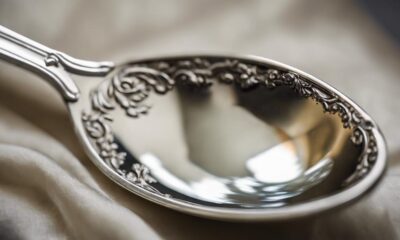
 Vetted2 hours ago
Vetted2 hours ago15 Best Silver Polish Brands to Make Your Silver Shine Like New
-

 Vetted5 days ago
Vetted5 days ago15 Best Fillers for Concrete Cracks – Expert Recommendations and Reviews
-

 Vetted1 week ago
Vetted1 week ago15 Best Plants for Large Pots to Transform Your Outdoor Space
-
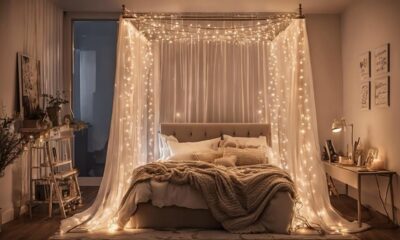
 Vetted6 days ago
Vetted6 days ago15 Best Fairy Lights to Transform Your Space With Magical Illumination
-

 Vetted1 week ago
Vetted1 week ago15 Best Folding Beds for Small Spaces – Space-Saving Solutions for Comfort and Convenience
-

 Vetted1 week ago
Vetted1 week ago15 Best Waterproof Flooring Options for Your Bathroom – Ultimate Guide & Reviews
-

 Vetted2 weeks ago
Vetted2 weeks ago15 Best Grocery Carts to Make Shopping a Breeze
-

 Vetted1 day ago
Vetted1 day ago15 Best Subfloor Options for Your Basement Renovation – Ultimate Guide










